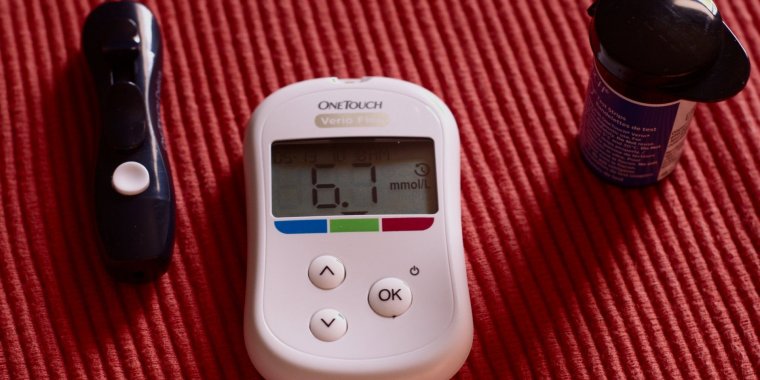| Health / Health News |
Brazilian researchers eye biosensors to monitor diabetes
Brazilian and US scientists have developed a glasses-based biosensor capable of measuring blood glucose levels through a person’s tears, offering a less invasive test for diabetics.

Many people with the disease use a portable glycosometer. Photo: Kate/Unsplash
Glucose levels need to be frequently monitored in people with diabetes, a disease that affects 380 million worldwide.
According to the World Health Organization (WHO), diabetes has been rising alarmingly in recent decades — with the fastest increase in low- and middle-income countries — and could affect 580 million people by 2035.
Many people with the disease use a portable glycosometer to measure blood glucose levels by pricking their fingertips to get a blood sample. The process, which may be repeated several times a day, can be painful and carries a risk of infection.
The Brazilian biosensor can identify an enzyme called glucose oxidase — widely used to detect free glucose in body fluids — in tears, eliminating the need for finger pricking. It can also measure blood sugar, vitamin and alcohol levels.
Biosensors are able to measure biological or chemical reactions and generate a signal proportional to the concentration of a particular substance. They are increasingly being designed and used to speed up laboratory test results, monitor health conditions, and diagnose and prevent disease.
Researchers from the University of São Paulo’s São Carlos Physics Institute, along with scientists from the University of California’s Department of Nanoengineering, in San Diego, immobilised the enzyme on an electrode coupled to a circuit with a constant flow of electrons, and then installed the device on the nose pad of the pair of glasses.
The user must produce tears by exposing their eyes to an eye-sensitive substance that stimulates the lachrymal gland.
As the tears come into contact with the glucose oxidase, it alters the flow of electrons, producing a signal that is recorded and processed by the device installed in the arm of the eyeglasses, which sends the results in real time to a computer or smartphone.
Laís Canniatti Brazaca, a physician and researcher at the São Carlos Chemistry Institute and one of the authors of the study published in Biosensors and Bioelectronics, told: “The concentrations of various metabolites in tears reflect concurrent blood levels, making them an attractive medium for non-invasive monitoring of physiological parameters.”
Apart from being painless, the biosensor could “decrease infections risk in people who frequently use glycosometers”, Brazaca added.
She said the device could also measure levels of vitamins and alcohol in the blood by “simply changing the coupled electrode attached on the eyeglasses’ nose pads”.
By using the same approach, a team of researchers from the State University of São Paulo Chemical Institute have created a biosensor able to detect and quantify biomarker proteins for clinical diagnosis of neglected diseases and chronic degenerative diseases, such as certain types of cancer.
Paulo Roberto Bueno, a materials engineer at the State University of São Paulo Chemical Institute said: “The idea is to conduct the exam using just a drop of blood on the device.”
This simple approach could improve diagnosis of diseases by medical professionals, or by patients themselves at home, aided by artificial intelligence software. (SciDev.Net)
YOU MAY ALSO LIKE





